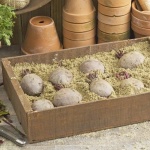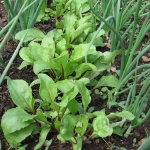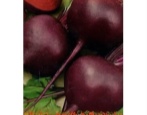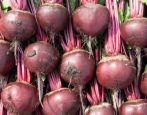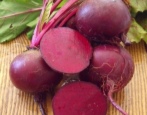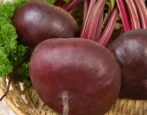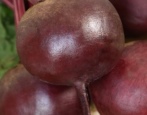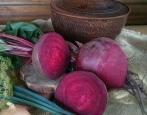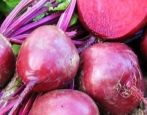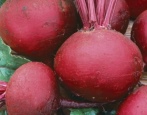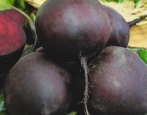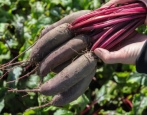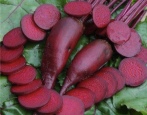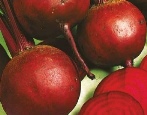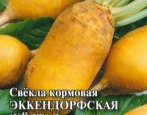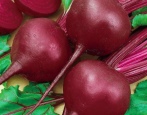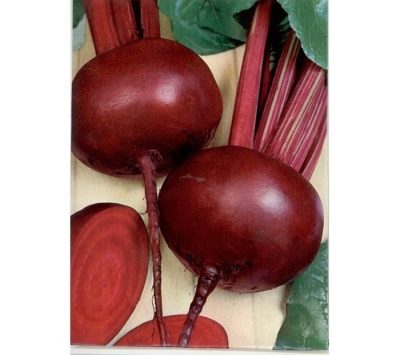
- Year of approval: 1943
- Leaf rosette shape: semi-upright
- Leaves: oval, green, medium bubbly, medium waviness
- Petiole: bottom side red
- The form: round and round-flat
- Weight, g: 230-500
- Cork head: weak
- Pulp color : intense red
- Ringiness: rings are weak
- Taste qualities: good and excellent
Bordeaux 237 beetroot is a fairly popular variety, among the advantages of which are high yields and resistance to harsh conditions. Today it is one of the popular varieties that is grown both in the south and in the north. It is worth considering the characteristics of Bordeaux 237 in more detail.
Breeding history
The breeding of the variety was carried out by domestic breeders from the scientific center. For the first time they received the culture in 1937. Only 6 years later, the variety was included in the State Register.
Description of the variety
Beet Bordeaux 237 is a variety that belongs to the group of plants with a medium early ripening period. It features a rich green tops with strong stems and wide leaves, which is convenient for harvesting.
Bordeaux 237 beets are also known as single-seeded beets, as they can germinate from a single seed without additional selection or processing of the material. A tenacious plant is capable of producing a crop several times a year, which is an undoubted advantage of the culture.
Characteristics of the appearance of the plant and root crops
The variety is suitable for planting in open ground both as seeds and through seedlings. Root characteristics:
- shape - mostly round;
- fruit diameter - up to 15 cm;
- weight - from 230 to 500 g.
The fruits are half sticking out of the ground. The skin of the beets is thin, maroon shade, underneath is a dense and juicy burgundy pulp. Root crops perfectly withstand transportation and do not lose their taste and useful properties.
Purpose and taste of tubers
Beetroot has a pleasant sweet taste, which was appreciated by the tasters. A juicy root vegetable is suitable for preparing first and second courses, various preparations. If desired, beets can even be frozen, and the fruit will not lose its taste.
Maturation
On average, a crop forms fruits in 70 days in the southern regions, which makes it possible to obtain a second harvest in a season. In the northern regions, the ripening period increases to 110–120 days.
Yield
The yield per hectare reaches 45–80 tons. Bordeaux 237 beets are popular with owners of agricultural enterprises who grow crops on an industrial scale.
Growing regions
Today, the variety is in demand in the southern regions of Russia, since they have a chance to grow the plant twice in the summer and get twice the yield. Also, Bordeaux beets are grown in Ukraine, Belarus and Moldova.
Growing and care
Bordeaux 237 beets, unlike other varieties, have increased resistance to external influences, and the seeds of the culture quickly take root even in harsh conditions. Before you start planting a plant, you should prepare the seed. Stages:
- Selection. First, the seeds are carefully sorted out, leaving large and undeformed samples. The rest are weeded out.
- Disinfection. It is carried out by soaking in a solution of potassium permanganate, which allows you to strengthen the immunity of the future plant.
- Treatment. To do this, use growth-stimulating compounds that can be purchased at gardening stores.
In the northern regions, they first plant in special containers, thus growing seedlings for subsequent transplantation into open ground. 2 weeks before planting the beets in the ground, the soil is prepared by applying fertilizers and carefully loosening the surface. Seed planting scheme:
- maintain a distance of 30 cm between the rows;
- 10 cm recede between the seeds;
- planting depth - 1–2 cm.
Work is usually carried out in the middle or late spring, when the air warms up to + 15 ° C. To achieve high yields, you should take care of plant care. There are some basic points to consider.
- Watering. To obtain large root crops, you should abundantly and regularly water the seedlings and grown beets, adding water 1-2 times a week. In a drought, it is necessary to increase watering, and in a rainy season, stop.
- Loosening. An obligatory procedure, with the help of which it will be possible to saturate the soil with oxygen and accelerate the flow of nutrients to the roots of the beets for the formation of large and juicy root crops.
- Weeding. Should be regular, especially for young sprouts. Timely removal of weeds will prevent the development of diseases and attacks of pests on the crop.
- Top dressing. The first fertilizers are applied at the beginning of the season almost immediately after planting seeds or seedlings, using organic matter or nitrogen. Further feeding is carried out during the formation of root crops. In this case, preference is given to compositions with phosphorus, boron and potassium.
Growing beets Bordeaux 237 on soils with low fertility or high acidity will require the use of additional fertilizers. The selection of dressings should be carried out taking into account the characteristics of the soil. Before using the formulations, you must carefully study the instructions so as not to harm the future culture.
The disadvantage of the variety is that the root crop is able to absorb and accumulate nitrates that are harmful to the human body. Therefore, the use of regular feeding requires careful application. Do not exceed the dosage so that the roots are beneficial, not harmful.

Beetroot tolerates cold snaps, therefore it is widely grown in the open field. When planting beets, you need to correctly determine the sowing time, choose a suitable place, prepare the beds, and do pre-sowing seed treatment.
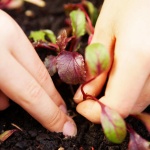
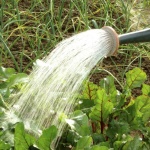
Soil requirements
It is not difficult to take care of beets if you correctly approach the choice of the site on which the variety will grow in advance. It will not be superfluous to follow the recommendations.
- It is necessary to grow a crop in sunny and calm areas.
- Do not plant beets where cruciferous plants used to grow. Instead, it is best to plant the seeds where tomatoes, garlic, eggplant and onions were previously grown.
- Beets prefer light soils with an alkaline composition and deep groundwater. The stagnation of fluid under the roots leads to their rotting and the appearance of various diseases. Therefore, if the site is located in a lowland, it is worth thinking about the device of the drainage system.
Beets require a lot of space to form large root crops. Therefore, it is not recommended to plant seeds or sprouts too close to each other. The optimal distance was given in the diagram to follow.
Disease and pest resistance
Bordeaux 237 shows excellent resistance to most diseases and pests. However, this does not mean that the plant is not capable of getting sick. With improper care, the plant is attacked by fungi, infections and various insects.Therefore, it is recommended to carry out preventive treatments of seeds and crops as it grows and before the formation of fruits. When using special drugs, you should carefully read the instructions.

Review overview
Bordeaux 237 beets are considered one of the high-yielding varieties, the additional advantages of which include:
- excellent taste characteristics of root crops;
- single-seededness;
- resistance to temperature extremes;
- transportability;
- lack of requirements for care.
